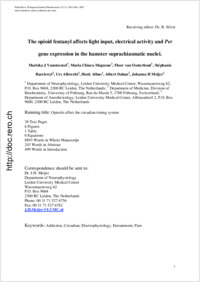The opioid fentanyl affects light input, electrical activity and Per gene expression in the hamster suprachiasmatic nuclei
- Vansteensel, Mariska J. Department of Neurophysiology, Leiden University Medical Centre, Leiden, the Netherlands
- Magnone, Maria Chiara Department of Medicine, Division of Biochemistry, University of Fribourg, Switzerland
- Oosterhout, Floor van Department of Neurophysiology, Leiden University Medical Centre, Leiden, the Netherlands
- Baeriswyl, Stéphanie Department of Medicine, Division of Biochemistry, University of Fribourg, Switzerland
- Albrecht, Urs Department of Medicine, Division of Biochemistry, University of Fribourg, Switzerland
- Albus, Henk Department of Neurophysiology, Leiden University Medical Centre, Leiden, the Netherlands
- Dahan, Albert Department of Anaesthesiology, Leiden University Medical Centre, Leiden, the Netherlands
- Meijer, Johanna H. Department of Neurophysiology, Leiden University Medical Centre, Leiden, the Netherlands
-
24.06.2005
Published in:
- European Journal of Neuroscience. - 2005, vol. 21(11), p. 2958
English
The suprachiasmatic nuclei (SCN) contain a major circadian pacemaker, which is regulated by photic and nonphotic stimuli. Although enkephalins are present in the SCN, their role in phase regulation of the pacemaker is largely unknown. The opioid agonist fentanyl, a homologue of morphine, is an addictive drug that induces phase shifts of circadian rhythms in hamsters. We observed that these phase shifts are blocked by naloxone, which is a critical test for true opioid receptor involvement, and conclude that opioid receptors are the sole mediators of the actions of fentanyl on the circadian timing system. A strong interaction between opioids and light input was shown by the ability of fentanyl and light to completely block each other's phase shifts of behavioural activity rhythms. Neuronal ensemble recordings in vitro provide first evidence that SCN cells show direct responses to fentanyl and react with a suppression of firing rate. Moreover, we show that fentanyl induces a strong attenuation of light-induced Syrian hamster Period 1 (shPer1) gene expression during the night. During the subjective day, we found no evidence for a role of shPer1 in mediation of fentanyl-induced phase shifts. Based on the present results, however, we cannot exclude the involvement of shPer2. Our data indicate that opioids can strongly modify the photic responsiveness of the circadian pacemaker and may do so via direct effects on SCN electrical activity and regulation of Per genes. This suggests that the pathways regulating addictive behaviour and the circadian clock intersect.
- Faculty
- Faculté des sciences et de médecine
- Department
- Département de Biologie
- Language
-
- English
- Classification
- Biological sciences
- License
-
License undefined
- Identifiers
-
- RERO DOC 5166
- DOI 10.1111/j.1460-9568.2005.04131.x
- Persistent URL
- https://folia.unifr.ch/unifr/documents/299971
Statistics
Document views: 170
File downloads:
- Texte intégral: 299
